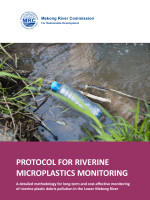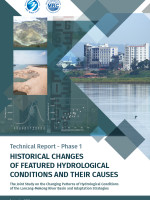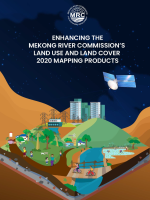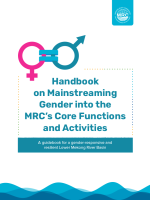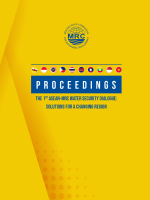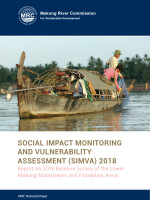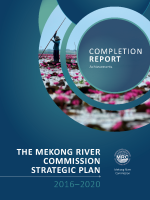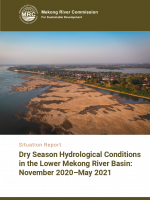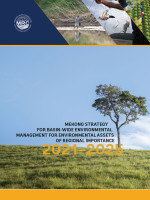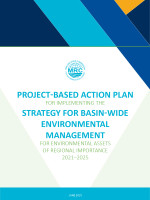Publications related to Climate Change
Protocol for Riverine Microplastics Monitoring
A detailed methodology for long-term and cost-effective monitoring of riverine plastic debris pollution in the Lower Mekong River
With a recent study identified the Mekong River as one of ten rivers to contribute over 90% of plastic debris to the world’s marine environment, there is an urgent need for a reliable data and information on riverine plastic debris pollution and their impacts to the aquatic environment of Mekong River. This Protocol for Riverine Microplastic Monitoring has been developed and finalized as one of three protocols of the MRC’s Detailed Methodology for the Long-term and Cost-effective Monitoring of Riverine Plastic Debris Pollution in the Lower Mekong River Basin (LMB). The finalization of the detailed methodology was made possible through the concerted efforts and commitment of the MRC Member Countries and support of experts at national, regional and global levels, and included rigorous processes of consultations, capacity building, and piloting to ensure that the methodology is adapted to the situation of the LMB. The methodology aims to provide the much-needed data and information for an improved knowledge and understanding on the pathway and behaviors of plastic debris pollution in the LMB, from land-based sources to riverine environment, and ultimately to the marine environment. Information derived from the long-term implementation of methodology can be used to assess the effectiveness of plastic waste management the LMB.
Download | DOI: 10.52107/mrc.bh5hvu | Published on: 19 Jan 2024 | Language: English
Technical Report – Phase 1 of the Joint study on the Changing Patterns of Hydrological Conditions of the Lancang-Mekong River Basin and Adaptation Strategies
This is the 1st phase report of the Joint Study on the Changing Pattern of Hydrological Conditions of the Lancang-Mekong River Basin and Adaptation Strategies, conducted by the MRC and LMC Water Center. The report identifies two key factors that contribute to hydrological changes in the LMB. First are natural factors, including precipitation patterns, evaporation rates, soil properties and topography. Second are human activities, such as infrastructure development, water management, land cover and land-use changes. These two factors interact and influence the amount, timing and water distribution within the Basin.
Download | DOI: 10.52107/mrc.bd0zhw | Published on: 05 Oct 2023 | Language: English
Enhancing the MRC Land Use and Land Cover 2020 Mapping Products
This report summarizes the process starting from the background of the project, field data collection, and most importantly, the process of applying the Earth Observation technology via machine learning using the Google Earth Engine platform and the approach agreed by the expert group from the Member Countries to update the land cover and land use map of 2020 for the Lower Mekong Basin region.
Download | DOI: 10.52107/mrc.aqrsbr | Published on: 08 Jun 2023 | Language: English
Handbook on Mainstreaming Gender into the Mekong River Commission’s Core Functions and Activities: A Guidebook for a Gender-Responsive and Resilient Lower Mekong River Basin
The Handbook for Gender Mainstreaming into the MRC Core Functions and Activities offers a supporting tool – or a guiding note – to assist the MRC to effectively integrate a gender perspective into all aspects of its work, from the development, update and application of strategic tools, procedures, normative guidelines, studies, and organizational strengthening to designing and advocating for joint actions. It also provides a working aid to integrate gender perspectives during the course of the BDS 2021–2030 and SP 2021-2025 implementation, and beyond
Download | DOI: 10.52107/mrc.ajutqn | Published on: 30 Dec 2022 | Language: English
Proceedings of the 1st ASEAN-MRC Water Security Dialogue: Solutions for a Changing Region
This is the proceedings of the 1st ASEAN–MRC Water Security Dialogue, organized on 19–20 August 2021. It captures key messages from the Dialogue, which serves as a platform to exchange novel ideas and identify possible areas for collaboration to further strengthen regional and local capacities in addressing water scarcity, water pollution, and water-related disaster risks, such as flood and drought. The inaugural ASEAN–MRC Water Security Dialogue tables three thematic solutions related to policy, technology, and partnership that can help countries in the Mekong and broader ASEAN address existential water security challenges that confront the region.
Download | DOI: 10.52107/mrc.ajutqy | Published on: 10 Jun 2022 | Language: English
Social Impact Monitoring and Vulnerability Assessment (SIMVA) 2018
Report on 2018 baseline survey of the Lower Mekong mainstream and floodplain areas
SIMVA 2018 is the third survey of its type and was conducted in the same sites and used the same methods of collecting primary household and village data, as the SIMVA 2014 and 2011 exercises. Covering 2,800 households in 200 villages the 2018 survey shows that communities in the Mekong mainstream corridor were still dependent on the river resources for their livelihoods, income, and well-being. As such, they are still vulnerable to changes in the Mekong water resources. However, their overall dependency has decreased with other, non-water resources-related livelihood activities playing increasingly important roles. From 2014 to 2018 the percentage of households engaging in fishing decreased across the region from 50% to approximately 37%. The study also indicates growing incidence of flooding, possibly as a result of climate change and other factors, including water infrastructure development. Government support in livelihood diversification and disaster coping strategies is essential and there is much room for improvement in this regard.
Download | DOI: 10.52107/mrc.qx5ynt | Published on: 18 Oct 2021 | Language: English
Completion Report for the MRC Strategic Plan 2016–2020
Achievements the Completion Report 2016–2020 presents the MRC’s key
Achievements in terms of the completion of outputs, the achievements of outcomes and financial performance during the five-year implementation of the MRC Strategic Plan 2016–2020 and its Annual Work Plans. It also includes the lessons learned from that period, and how they formed the basis of the next planning cycle – the Basin Development Strategy 2021–2030 and the MRC Strategic Plan 2021–2025.
Download | DOI: 10.52107/mrc.qx5ynu | Published on: 23 Jul 2021 | Language: English
Situation Report on Dry Season Hydrological Conditions in the Lower Mekong River Basin: November 2020–May 2021
This Situation Report presents a preliminary analysis of the Lower Mekong River Basin hydro-meteorological conditions over the 2020–2021 dry season. It shows fluctuations in water levels in the upper reaches of the Mekong mainstream in Lao PDR and Thailand, as well as low water volume stored in the Tonle Sap Lake. Rainfall in April–May was the highest on record for these months for the last 18 years in places. Overall, flows in the Mekong in the first five months of 2021 were also higher than the long-term average, except for December 2020 where flows in the Mekong mainstream were closer to normal. But river flows did not increase significantly.
Download | DOI: 10.52107/mrc.qx5yo1 | Published on: 30 Jun 2021 | Language: English
Mekong Strategy for Basin-wide Environmental Management for Environmental Assets of Regional Importance 2021–2025
The Mekong Strategy for Basin-wide Environmental Management for Environmental Assets of Regional Importance (SBEM) is a cooperative regional strategy to protect environmental and ecological assets, including those providing ecosystem services in the basin. It provides an opportunity to implement a cooperative strategy where capacity can be built, and best management practices and information can be shared. Ultimately, the SBEM will establish a permanent regional network of environmental assets of regional importance within the LMB, which will be protected and managed for generations to come.
Download | DOI: 10.52107/mrc.ajutqu | Published on: 21 Jun 2021 | Language: English
Project-based Action Plan for Implementing the Strategy for Basin-wide Environmental Management for Environmental Assets of Regional Importance 2021–2025
This report provides practical guidance to Member Countries and partners on implementing the strategic priorities and actions of the Strategy for Basin-wide Environmental Management through a coordinated approach. It describes a set of 13 projects forming a coherent work programme across the 12 priority environmental assets of regional importance. The report includes a sustainable funding strategy for Member Countries and the MRC to pursue, an outline of the governance, roles and responsibilities, risk management and monitoring, evaluation and reporting arrangements.
Download | DOI: 10.52107/mrc.qx5ynx | Published on: 21 Jun 2021 | Language: English
